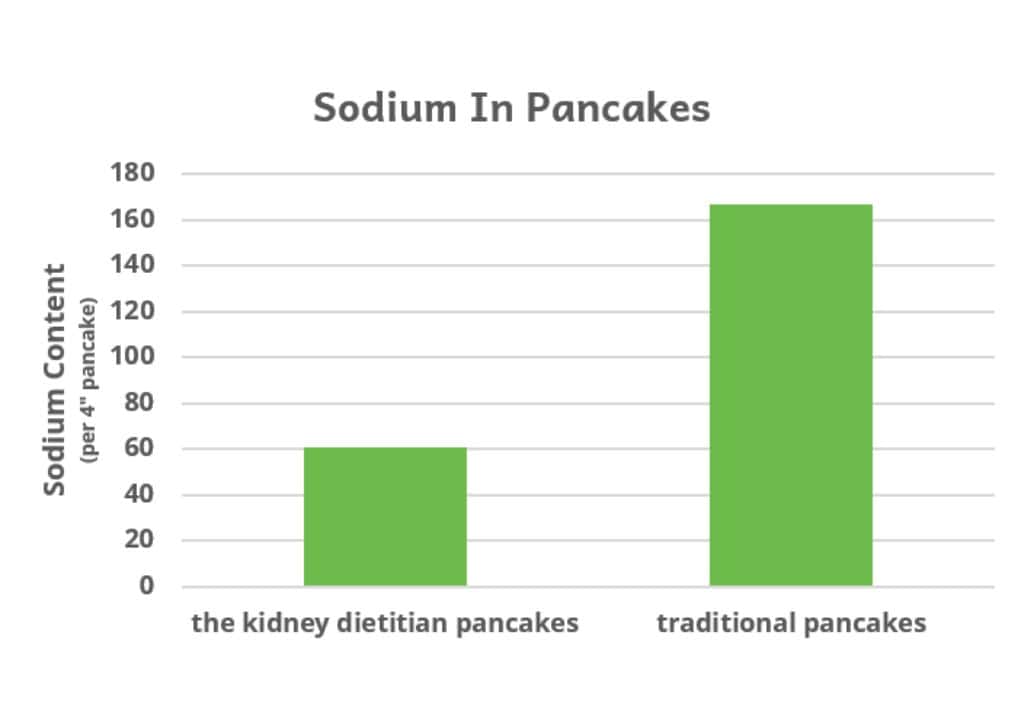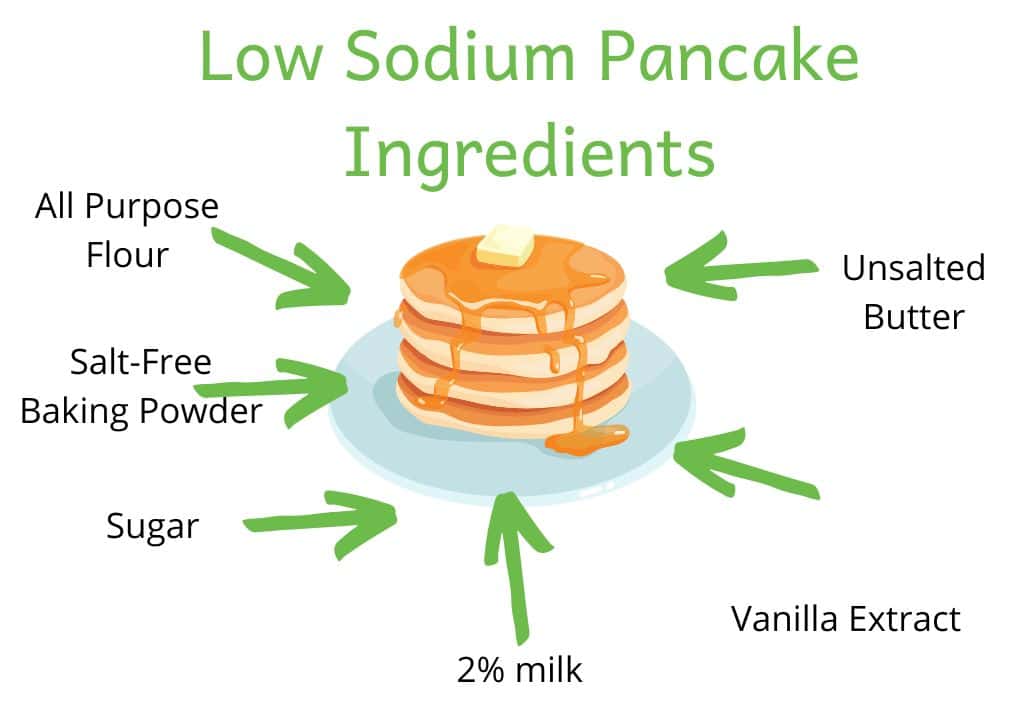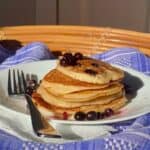This article was written by dietetic student Rebecca Webb & reviewed by Melanie Betz MS, RD, CSR, FAND.
Love pancakes, but don’t want the salt? In this recipe, you’ll see low sodium pancakes can be just as tasty!
*Please note that this post contains clearly identified affiliate links. As an Amazon affiliate, I may earn a small commission on qualifying purchases (at no extra cost to you).
Table of Contents
Sodium In Pancakes
Pancakes don’t taste salty, so do they really have much sodium? The answer is often yes. The USDA estimates that the average plain, 4-inch pancake has about 167 mg of salt, although many recipes may contain even more (1). So, this means if you had 3 small pancakes for breakfast, you would be eating over 500 mg of salt! Add a side of bacon or sausage and you could easily hit 1,000mg sodium!
The Dietary Guidelines for Americans recommends having no more than 2,300 mg of sodium a day (2). This means that a few small pancakes would be more than 20% of the daily recommendation. That’s a lot!
Eating too much sodium can lead to many health problems such as high blood pressure, heart disease, stroke, kidney stones, and kidney disease (2).
As seen in the chart, our low sodium pancakes contain less than half the sodium in average pancakes.

Substituted Ingredients in Low Sodium Pancakes
Where does the sodium in pancakes come from? There are a few surprising ingredients that contain salt.
Baking Powder
Yes, regular baking powder contains a surprising amount of sodium! Some examples out there include:
- Whole Food’s baking powder: 320 mg per tsp (3)
- Kraft Heinz baking powder: 480 mg per tsp (4)
- Bob’s Red Mill baking powder: 640 mg per tsp (5)
Even just a couple teaspoons of baking powder in a regular pancake recipe can contribute anywhere from 640mg -1,280mg to one batch of pancakes. That’s a lot of sodium!
Baking Powder Options for Low Sodium Pancakes
Despite all the sodium in baking powder, there are some low sodium and sodium free options that are great substitutes for traditional baking powder.
Hain Sodium-Free Baking Powder* is a great option to use in low sodium pancakes that contains no sodium. However, this baking powder is high in potassium (20% recommended intake per teaspoon). Too much potassium may be a problem for people with kidney disease.
Rumford Low-Sodium Baking Powder* is another great option to use in low sodium pancakes that only contains about 15% recommended intake per teaspoon. Unlike Hain’s Baking Powder, Rumford contains no potassium and is a better choice for people with kidney disease.
Use this information to help you decide which baking powder is right for you for low sodium pancakes. Unfortunately, these products can be difficult to find in store. But, they can be purchased online.
Milk
Even though milk doesn’t taste salty, it does have a little sodium! The amount of sodium in milk is pretty much the same no matter what type of milk you use.
Saturated Fat in Milk
Other than skim, milk has some fat.
Saturated fat is the type of fat that is commonly found in dairy products. Eating too much saturated fat may contribute to higher cholesterol levels and increased risk of heart disease (6). However, there is research to show that saturated fat from dairy may not be as harmful as saturated fat from other animal products (7).
The right milk for you depends on your own personal health needs and preferences. Ask your dietitian what is right for you!
Butter
Butter is another important ingredient in pancakes. It can be purchased as salted or unsalted. Using unsalted butter is another way to reduce salt intake. Salted butter has about 90 mg of salt per tbsp, whereas unsalted butter has very little sodium.
Butter is also a significant source of saturated fat in these low sodium pancakes. You can substitute a neutral flavored oil such as canola or avocado oil if you prefer.

Salt
And of course, there’s salt itself! Most recipes call for about 2 teaspoons of salt. This adds 4,720mg sodium to the recipe.
This recipe contains no additional salt. There are other ways you can add additional flavor to your pancakes to replace the salt taste.
Flavor Additions for Low Sodium Pancakes
To make up for the lack of salt in this recipe, consider adding some extra flavor to your low sodium pancakes. Here are some other flavors you could try!
Vanilla Extract
This recipe already has vanilla extract, but you can add a little more if you really like the vanilla flavor. Consider an additional teaspoon!
Fruit
Try adding fruit to your pancakes for extra flavor and sweetness.
Keep in mind that some fruits such as bananas are high in potassium. Too much potassium may not be the best option for some people with kidney disease. Blueberries and strawberries are great lower potassium options.
Spices
Add spices such as cinnamon or pumpkin spice for some extra flavor! You could try adding apples and cinnamon to this recipe for a fall-inspired pancake.
Other Considerations for Low Sodium Pancakes
There are some things people often add to pancakes that could make this recipe less kidney-friendly .
Protein Powder
Many people like to add protein powder to their pancakes. Although protein is important in any diet, too much protein can add additional stress to the kidney and contribute to kidney stones or make kidney disease worse (8).
Added Sugar
Adding ingredients like maple syrup or chocolate chips adds more sugar. Of course, some added sugar is okay, but too much added sugar can increase risk for, diabetes, kidney disease, kidney stones, heart disease, and other health issues (9).
If you like these ingredients with your low sodium pancakes, consider using a little less and adding some fruit for sweetness!
Low Sodium Pancake Mix
With this recipe, you can also store the dry ingredients as a pancake mix to use for later! Just add the wet ingredients when you are ready to enjoy some pancakes.
Commercial Low Sodium Pancakes
There are also a few low sodium pancake mixes that you can purchase at the supermarket! A few options include:
- Sweet N’ Low Pancake Mix*: 20 mg sodium/serving (contains potassium and phosphorus additives)
- Ahura Z’s Salt Free Pancake Mix: 0 mg sodium/serving (contains potassium additives)
- Sturdiwheat Low Sodium Pancake Mix with Sea Salt*: 135 mg sodium/serving (contains phosphorus additives)
Hope you enjoy these low sodium pancakes!
Low Sodium Pancakes
Ingredients
- 1 1/2 cup all-purpose flour
- 2 teaspoons salt-free baking powder
- 2 tablespoons sugar
- 1 1/2 cup 2% milk
- 2 tablespoons unsalted butter melted & cooled
- 2 eggs
- 1 teaspoon vanilla extract
Instructions
- In a large bowl, combine flour, baking powder and sugar.
- In a separate bowl, whisk eggs, milk, melted and cooled butter, and vanilla extract.
- Once mixed, pour wet ingredient mixture into the dry ingredient mixture.
- Combine ingredients by slowly folding the wet ingredients into the dry mixture until batter is formed. DO NOT OVERMIX. Some lumps are okay – small bubbles should be present in the batter.
- Optional: to achieve a lighter pancake, you may choose to let the batter rest for 10-15 minutes.
- Lightly spray or brush your skillet with canola oil or butter. Bring skillet to medium heat.
- Once heated, scoop some batter onto the skillet using a ¼ measuring cup. Let batter sit for 1-3 minutes. You can tell the pancake is ready to flip when the batter begins to bubble, and the edges start to brown.
- Optional step: add desired toppings (such as blueberries) to pancake before flipping.
- Flip and repeat on the other side until lightly browned.
- Repeat this process for every pancake. You will need to reapply more oil/butter to the skillet before every pancake. You may also have to decrease the stovetop temperature once the skillet gets very hot – adjust as needed.


So this could be used to make muffins or banana bread
It might be a bit more gummy than you are looking for in a muffin or banana bread. But you just added low sodium muffins and banana bread to my to-do list!
I like the recipe for low sodium pancakes.
Potassium: Banana bread – as a snack: is this high in potassium also?
Added sugars: can you share – which sugars are kidney and diabetic friendly : stevia or organic brown sugar?
Thank you,
I’m so glad you enjoyed this recipe! And yes, banana bread would certainly be higher in potassium vs. other quick breads. All sugar is sugar. Brown sugar, white sugar, honey, agave are all types of sugar. I’m ok with reasonable amounts of ANY sugar substitute for both diabetes and kidney disease – but ask your dietitian what is best for you!
“Keep in mind that some fruits such as bananas are high in potassium. Too much potassium may not be the best option for some people with kidney disease. Bananas and strawberries are great lower potassium options.”
First sentence says, “bananas are high in potassium”. Last sentence says, “Bananas… are great lower potassium options.”???
Thanks for pointing out this typo. It has been fixed!
How many eggs???
Two!